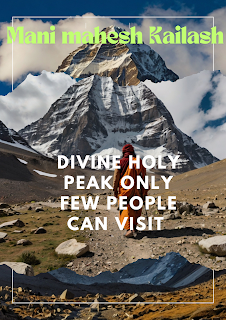Adi Kailash: The Holy Pilgrimage of the Mini Kailash
Introduction
Adi Kailash is sometimes called "Chhota Kailash" or "Mini Kailash." It is actually one of the most sacred yet lesser-trodden places of pilgrimage in India. Situated deep inside the Himalayas, in the Kumaon region of the state of Uttarakhand, near the Indo-Tibetan border, this destination lies in a remote corner. The trek to Adi Kailash provides a soul-stirring experience to the pilgrims, the adventurous ones, and nature lovers- including the valuable opportunity to view breathtaking landscapes as well as majestic snow-clad peaks with a spiritual journey to one of the most important sites in Hindu mythology.
The importance of Adi Kailash is in terms of its religious and cultural value. It is said to be one of the homes of Lord Shiva, like the much better-known Mount Kailash in Tibet. But Adi Kailash is still unknown and thus offers a more serene and isolationist journey through pilgrimage. Here, we'll be covering everything you need to know about the Adi Kailash Yatra-from history to route, travel requirements, budget, to useful tips to make your way there smoother
History and Significance of Adi Kailash
This is a holy place that has been enjoyed by the human hearts for centuries, with its significance deeply rooted in the mythology of Hindus. It is said to be one of the alternate locations where Lord Shiva lives. The name "Adi Kailash" actually means "Original Kailash," which emphasizes its value as a center of energy and power that has spiritual importance. Many pilgrims cannot afford to make the long trek to Mount Kailash. So they take Adi Kailash, much nearer. Yet at the same time, they do not lose their sacred deity.
The trek to Adi Kailash is also highly associated with Om Parvat, a mountain right next to it. The natural snow image on Om Parvat appears like the sacred "Om" symbol. In Hinduism, great importance is attached to the "Om" symbol. This phenomenon enhances its spiritual value and this place is a must for those wanting divine blessings with all scenic beauty in one go.
Route to Adi Kailash
Start: Dharchula
The starting point is mostly at Dharchula, town situated in the Pithoragarh district of Uttarakhand. Dharchula is an appealing small town sited nearly the Indo-Nepal border and serves as a base for several treks, such as Om Parvat trek and Adi Kailash trek.
Dharchula can be approached by road from Delhi, Dehradun, or Haldwani. The nearest railways station to the town is in Tanakpur, which is situated at 215 kilometers from Dharchula. Pantnagar Airport is the nearest airport, located at 285 kilometers.
Trekking Itinerary
1. Dharchula to Gunji (Drive and Trek) Drive from Dharchula to Gunji: It is a very scenic drive by the side of Kali River which marks the Indian-Nepal boarder. The trek starts at Mangti towards Gunji it's about 60 Km from Dharchula that is at the altitude of 3,200 meters from sea level. Altitude increases gradually making this a gentle trek.
2. Trek to Nabi and Kuti from Gunji Spend a night in Gunji and trek to Nabi and Kuti- traditional villages, giving you a feel of the life led by the Bhotia people living in the region. These villages are quite beautiful, situated between massive peaks and make perfect stopping places for short stays. The trek distance from Gunji to Kuti is about 14 kilometers.
3. Kuti to Adi Kailash Base Camp (Trek) This trek takes you from Kuti for 12 kilometers up to the base camp of Adi Kailash. Just to catch a glimpse of the top of Adi Kailash against the backdrop of surrounding scenery is a breathtaking view. The trek is so dramatic that it takes you through high-altitude meadows, rugged mountainous lands, and glacial streams-a complete adventure.
4. Adi Kailash Darshan At the foothill of Adi Kailash, the devotees get a chance to worship the sacred peak and enjoy its religious activities as meditation and prayers. The stillness of this majestic environment gives flavors to this whole experience.
5. Return Journey After spending time at Adi Kailash, the return trek follows the same route back to Dharchula, with stops at Kuti and Gunji.
Best Time to Visit Adi Kailash
The best time to undertake the Adi Kailash Yatra is from May to October, during the summer and autumn seasons when the climate is moderately stable, mostly clear, and manageable, fitting well for trekking. Since it is raining during monsoon time (July-August), it is not advisable to venture into this trek as one may face several landslides and slippery trekking routes.
June and September are the peak months of the pilgrimage as these months have better climatic conditions, with lesser chances of rain and greater visibility to the peaks.
Expense Account for Adi Kailash Yatra
1. Transportation Expenses
Delhi to Dharchula:
Train journey from Delhi to Tanakpur: ₹500–₹1,500; class depending
By Bus/Shared Jeep from Tanakpur to Dharchula: ₹800–₹1,200
Private taxi for a group: ₹6,000–₹8,000
Return Journey from Dharchula: ₹2,500–₹5,000 (depending on the medium)
Accommodation
Dharchula: ₹800–₹1,500 per night (budget hotels)
Villages (Gunji, Nabi, Kuti): ₹500–₹1,200 per night (homestays or guest houses)
Permit Fees
Adi Kailash is close to the Indo-Tibetan border so a permit is required to be taken to visit the area. The ILP costs approximately ₹200–₹500 for one person and can be collected at Dharchula after submitting the documents required along with ID proof, passport-sized photographs, etc.
4. Trekking Package (with guide, meals, and accommodation)
Trekking agencies generally provide a holistic package with transport, services of a guide, permits, meals, and accommodation during the trek. The Adi Kailash trekking package generally is on a per person basis with the range falling between ₹35,000 to ₹50,000. In the large part, the cost is hugely based on services offered and trek duration.
5. Other Costs
All Meals during travel and trek (if not included in package) ₹500- ₹1,000/- per day
Individual expenses - on or above trek (treats, bottled water, etc.): ₹1,000–₹3,000
Total Estimated Budget: ₹40,000 to ₹55,000 per person (including travel, accommodation, permits, and trek package)
Permits and Documentation
To visit the Adi Kailash region, an Inner Line Permit (ILP) is required. Since the region is close to the Indo-Tibetan border, the government prohibits accessibility to this region in the interest of security and safety. You can collect your permits from Sub-Divisional Magistrate's Office in Dharchula.
List of documents to obtain the permit:
Government issued photocolour Id proof - Aadhaar card, Voter ID or Passport
Passport size photographs with white background, three to four copies
Medical certificate in case of high altitude trek
Carry photocopies of all these document details for submitting them at various check-posts on the route.
Fitness and Health Precautions
The Adi Kailash trek requires moderate to high levels of fitness since it involves high altitude and rugged terrain. Physically, one needs to prepare for the trek by doing cardio exercises, strength building, and flexibility workouts at least 2-3 months before the trek. Breath-related exercises and yoga would be of great help in acclimatization to the altitudinal levels.
Some of the important health considerations are :
Acclimatization: Spend time in the high altitude stops, like Gunji, so that your body can get accustomed to lesser oxygen.
Hydration: Drink enough water to avoid dehydration and mountain sickness.
Consult a doctor before starting the trek, especially if you have pre-existing medical conditions such as asthma, heart disease, and hypertension.
Take an elementary first aid kit along with medications to counter altitude sickness, pain killers, and digestive disorders.
Cultural and Environmental Factors
This holy journey demands high respects for the local traditions, customs and environment. The region is inhabited by Bhotia people, a tribe having its own way of life. Always respect their culture and beliefs.
Responsible tourism in the fragile Himalayan ecosystems is also warranted. Do not litter, and be respectful of the natural environment. Take nothing with you except impressions. Carry re-useable water bottles, less plastic as possible, and indulge in indigenous businesses, among other sustainable principles trekking should be based on.
This trek is an experience that one can enjoy once in a lifetime by embarking on a spiritual and adventurous journey. Whether you are one of the devout pilgrims seeking blessings from the divine or a nature lover searching for pristine Himalayan beauty, this trek will provide experiences that you never dreamed of. Silken bonding between nature's and human spirituality in the Himalayas is best testified in scenic lands rich in religious significance coupled with challenging yet rewarding treks of Adi Kailash.
Through proper preparation, respect for local culture,






0 Comments